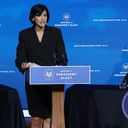CDC releases guidelines on safely reopening schools

School reopenings should be contingent on community transmission rates and should be a priority over restaurants and other nonessential businesses, the Centers for Disease Control and Prevention recommended Friday.
Why it matters: America's educators have been calling on the health agency to issue clear and useful guidance for schools, following mixed signals sent by the Trump administration last year.
The state of play: K–12 schools should close only after all other mitigation measures in the community have been employed, and the first to reopen when they can do so safely, the guidance says.
- "Reducing transmission in schools is a shared responsibility."
Four color-coded "zones" reflecting community transmission correspond to the types of instruction K-12 schools can use:
- Full in-person
- Hybrid
- Reduced attendance
- Virtual-only
Aside from masking and hygiene, the Education Department suggests using cafeterias and auditoriums for classes, staggering bell schedules and assigning one seat per row on buses.
- In-person teaching should be prioritized before sports or other extracurriculars.
- Districts with lower-income students or populations with disabilities should be prioritized for in-person instruction.
- Families of students at risk for severe illness can opt-out of in-person instruction.
- Teachers should be prioritized for vaccination but it should not be mandatory for reopening.
The big picture: Opening K-12 schools is a topic of intense disagreement among teachers and parents. Teachers unions have become a prominent feature of school reopening debates along with the public's anger.
- The science still says K-12 in-person school attendance is not a primary driver of community transmission. But when community rates of COVID-19 are high, so is an increased likelihood that infections could be transmitted within a school setting.
Background: President Biden has pledged to reopen K-8 schools within his first 100 days, but the White House has run into challenges it didn't foresee in December like delays in vaccine rollouts and the emergence of new virus variants.
- Meanwhile, White House press secretary Jen Psaki said on Tuesday after Biden committed to having the majority of schools open by his 100th day in office, that he meant more than 50% of them teaching at least one day per week in-person.
Yes, but: The Biden administration's bar may have been set too low, some experts say. Several nationwide databases tracking school reopenings show that 64% of elementary and middle school students are already seeing some in-person instruction, according to Tuesday data from Burbio's School Opening Tracker.
- And several state legislatures like Virginia, Wisconsin and Tennessee even took reopening guidance into their own hands this month, fearful if they wait any longer, there won't be enough time to safely orchestrate in-person learning this academic school year.
What to watch: Much of the supplies, testing and infrastructure for ventilation is contingent on what Congress is willing to divvy out to the states.